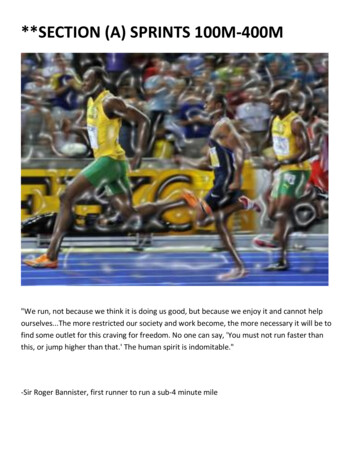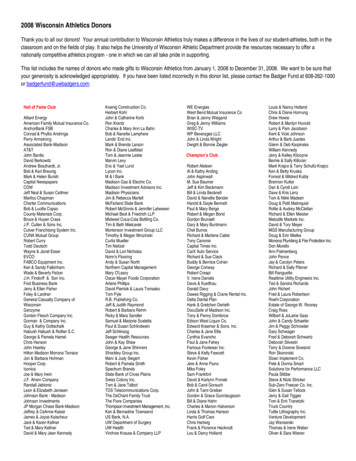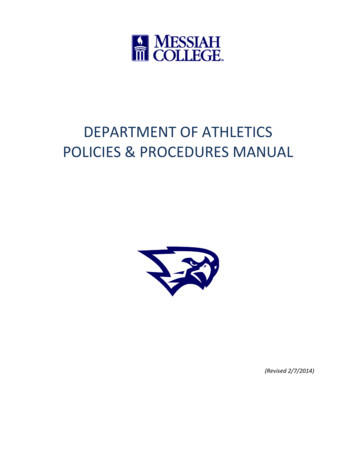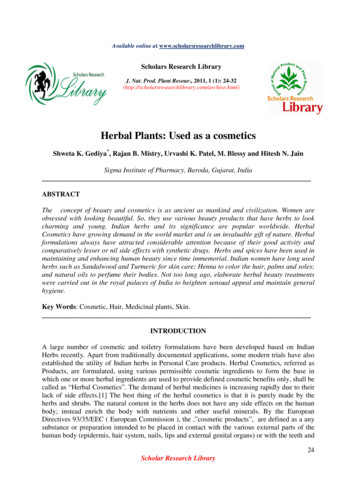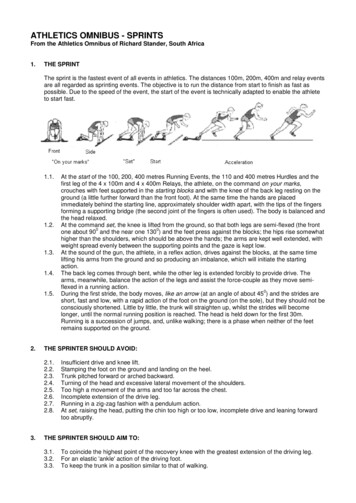
Transcription
ATHLETICS OMNIBUS - SPRINTSFrom the Athletics Omnibus of Richard Stander, South Africa1.THE SPRINTThe sprint is the fastest event of all events in athletics. The distances 100m, 200m, 400m and relay eventsare all regarded as sprinting events. The objective is to run the distance from start to finish as fast aspossible. Due to the speed of the event, the start of the event is technically adapted to enable the athleteto start fast.1.1.1.2.1.3.1.4.1.5.2.THE SPRINTER SHOULD AVOID:2.1.2.2.2.3.2.4.2.5.2.6.2.7.2.8.3.At the start of the 100, 200, 400 metres Running Events, the 110 and 400 metres Hurdles and thefirst leg of the 4 x 100m and 4 x 400m Relays, the athlete, on the command on your marks,crouches with feet supported in the starting blocks and with the knee of the back leg resting on theground (a little further forward than the front foot). At the same time the hands are placedimmediately behind the starting line, approximately shoulder width apart, with the tips of the fingersforming a supporting bridge (the second joint of the fingers is often used). The body is balanced andthe head relaxed.At the command set, the knee is lifted from the ground, so that both legs are semi-flexed (the front00one about 90 and the near one 130 ) and the feet press against the blocks; the hips rise somewhathigher than the shoulders, which should be above the hands; the arms are kept well extended, withweight spread evenly between the supporting points and the gaze is kept low.At the sound of the gun, the athlete, in a reflex action, drives against the blocks, at the same timelifting his arms from the ground and so producing an imbalance, which will initiate the startingaction.The back leg comes through bent, while the other leg is extended forcibly to provide drive. Thearms, meanwhile, balance the action of the legs and assist the force-couple as they move semiflexed in a running action.0During the first stride, the body moves, like an arrow (at an angle of about 45 ) and the strides areshort, fast and low, with a rapid action of the foot on the ground (on the sole), but they should not beconsciously shortened. Little by little, the trunk will straighten up, whilst the strides will becomelonger, until the normal running position is reached. The head is held down for the first 30m.Running is a succession of jumps, and, unlike walking; there is a phase when neither of the feetremains supported on the ground.Insufficient drive and knee lift.Stamping the foot on the ground and landing on the heel.Trunk pitched forward or arched backward.Turning of the head and excessive lateral movement of the shoulders.Too high a movement of the arms and too far across the chest.Incomplete extension of the drive leg.Running in a zig-zag fashion with a pendulum action.At set, raising the head, putting the chin too high or too low, incomplete drive and leaning forwardtoo abruptly.THE SPRINTER SHOULD AIM TO:3.1.3.2.3.3.To coincide the highest point of the recovery knee with the greatest extension of the driving leg.For an elastic 'ankle' action of the driving foot.To keep the trunk in a position similar to that of walking.
3.4.3.5.3.6.3.7.3.8.4.To keep the head upright and look straight ahead.To move the arms parallel with the hips and only slightly across the body.For a complete action of the drive leg in a horizontal rather than a vertical direction.To ‘run in a straight line’ placing the feet one in front of the other.At the command 'set' to move the body forward and at the pistol to drive forward with arm and legs.HOW TO DEVELOP SPEED?4.1.BY MOVING THE LEGS FASTER. IT IS CALLED LEG SPEED.Note: The leg speed of an athlete can be improved through training, but improvement on the athlete’spersonal best performance will be marginal. Please note that the leg speed of an athlete can decrease as a result of other types ofconditioning. Therefore leg speed should be maintained by means of regular leg speedconditioning exercises. Leg speed conditioning is most effective when the neurological andmuscular systems are rested. Sometimes the driving force (F mxa) of the athlete is developed but the neurological system ofthe athlete has not caught up yet.EXERCISES THAT WILL SPEED UP THE BALANCING BETWEEN THE NEUROLOGICAL ANDPHYSICAL FUNCTIONSByrunningregular30-50mtimetrails.By towing theathlete with amotorcycle at aspeed 0,1 - 0,3sec. faster than theathlete’s maximumleg speed, over30m with a 40mbuilds up.By runningdownhill. Theslope must notbe more than6º, and notlonger than50m.By pulling the athlete with anelastic band. The one end of theelastic band is tied to a pole andthe other end around the chestof the athlete. The athletemoves backwards until theelastic band is fully stretched.The athlete runs 10m, with theelastic band pulling.BY INCREASING THE STRIDE LENGTH, AND MAINTAIN IT THROUGHOUT THE RACE.By increasing the stride length of an athlete will improve the athlete’s personal best performancedramatically. However, to increase the stride length of the athlete requires a lot of strengthdevelopment and conditioning.To maintain increased stride length throughout the race takes years to develop.4.2.A LONG STRIDE LENGTH CAN BE OBTAINED .Lifting the knees higher.Run tall by running on your toes, hips forward and your back straight.Push explosively off the track. With the feet.Have good fore leg reach.Pump your arms vigorously.Bound forward, not up.Maintain good forward lean.Stay relaxed. Keep the jaw and hands relaxed.2
THE SEQUENCE TO FOLLOW WHEN EXERCISES ARE DONE TO DEVELOP STRIDE LENGTH: Walk through this exercise several times.Repeat, bounding forward off the toes slowly.4.2.8.1. Repeat the exercise, gradually increasing speed.EXERCISES TO DEVELOP STRIDE LENGTHExercises to develop stride length are not natural movements, so you must practice these exercises.The following exercises can be done to develop a good technique.HIGH KNEESREACH EXERCISEJog while lifting knees high,and move the foot down faststraight away.Practice exaggeratingreach of the foreleg asyou go down field ongrass.RUN HIGH ONTOES EXERCISEStand still. Rise ashigh on the toes aspossible. Run on thespot, high on thetoes, lean forwardfrom the heels, andrun down fieldstaying high on toes.LEAN EXERCISEStanding feet togetherand lean forward fromthe heels about 30º fromvertical. Maintain thislean while striding downfield.ARM REACHEXERCISEExaggerate your armreach without trying togo faster. Keep thelead arm low, andreach forward. You willnote you will run fasterwithout any extra effort.The hand of the trailingarm must not lift higherthan the hip.RUN TALL EXERCISEPut the hands against thewall. Back up as far as youcan with the heels on theground. Then rise onto thetoes, lift the leading knee,and feel the power. Notethat the heel, hip and headstay in line at all times.ARM EXERCISEBend the arms at the elbowuntil they are level with thehips, keeping the handscupped and relaxed.Keeping the arms parallel tothe direction of the run, pumpthem backward and forward.Drive from the elbows, keepingthe hands relaxed. First pumpslowly, then gradually faster toget more speedRELAXATION EXERCISERun 90% effort over 30 - 50 m,staying as relaxed as possible.Run with an exaggeratingloose jaw (let it flop around),and loose hands. Avoid 100%effort.BOUND FORWARD EXERCISEPractice bounding forward, not upwards, down the field so thatthe head stays in a straight line. Concentrate on having onefoot almost always on the ground, pushing against the ground.When jumping upwards, both feet will be in the air for a longperiod of time.BOUNCEEXERCISETo develop anklebounce, lock theknees and boundforward, by justflipping the ankles.3
5.HOW TO SUSTAIN TOP SPEED OVER A LONGER PERIOD OF TIME?Sustaining top leg speed over a longer period is called speed endurance. Maintaining top leg speed over alonger period will also improve the sprinting time of an athlete dramatically. However, it requires a lot ofstrength development and conditioning.To sustain top leg speed throughout the race takes years to develop.It is not natural to lift your knees high, to run on your toes, to push explosively off the track, or to pump yourarms vigorously. It is however natural that the athlete’s sprint form will deteriorates approximately 75% intothe race.It is therefore important that the athletes are taught to reaffirm their sprint form approximately 25m from thefinish line. (50 m in a 200m race and 75m in a 400m race.) At this point, they must develop a conditionedreflex to a word e.g. lift or faster, at which they:5.1.5.2.5.3.5.4.5.5.5.6.Take a breath and gather mentally for the finish.Lift the knees higher.Pump the arms faster, or if this is not possible, reach with them forward about as high as the navel.Get up on the toes and run tall.Stay loose by keeping the jaw and hands relaxed.Focus the eyes on the finish line and do not look around.This sustaining of speed requires great strength and conditioning. A lot of sprint form exercises must bedone, until these drills become habit, even in the heat of the battle.6.HOW TO FINISH A RACE?Drive through the finish line as though the finish were 10m beyond, while maintaining form.Lean forwards right at the tape and throw only one shoulder into the tape. In the case of a close race, it iseasier to see a shoulder than an entire torso. It is also easier to maintain form this way.7.HOW TO START A RACE?Starting exercises should not be done within the first three weeks of conditioning, due to the big injury risk.Prior to race or start exercises, the athletes must first warm up properly and stretch their muscles, tendonsand ligaments. They must also get to their blocks early and take slow starts, then a few fast starts.7.1.GETTING IN THE BLOCKSThe block settingand position fromthe start line.At the command “onyour marks” theathlete must get infront of the blocksand back into theblock. Place the footin the lead blockfirst, with the toebarely touching theground.Then back solidly into therear block.Sit on the heels,locking the legsin the blocks, andclean rocks orsand off thehands.Now put yourhands just behindthe line with thefingers in a higharch.4
Hands are cupped; thumband index finger justbehind the line, anddirectly below theshoulder.Both arms are straightand locked in the elbows.Head is down; neckrelaxed and the jaw lose.The eyes are on a spot2m down the track.7.2.BLOCK SPACING 7.3.The weight is comfortable, well forward; Head low; neckrelaxed; shoulders are forward of hands, directly above theline; the eyes on a spot 2m down the track. Considerableweight is on the hands. Hands are behind the line; feet arebraced solidly against the blocks; body is relaxed; mind is alert.There is no fixed position for the blocks to be placed. Experiments with the block spacing tosee which position gives you the fastest start over 20m.The only rule is that the lower legs must both be in a parallel line to each other in the setposition, to enable the athlete an effective drive from the blocks.Both knees must tough the line in the ‘on your marks’ position.Allow the athlete to come in the ‘set’ position with both feet next to each other, without theblocks.Both legs must be bending at an angle of 90º.Move the trailing leg backwards until the lower legs are parallel to each other, and one-footlength behind each other.The feet must be one hand width apart to give stability during the driving phase.Mark the position of the feet on the ground, and ask the athlete to move away.Place the blocks (both are set at an angle of 45º) on the ground in the same position as themarks on the ground.Ask the athlete to get back in the set position in the blocks, and do minor adjustments witheach start until the best time over 20m is achieved.The longer the athlete, the further the blocks will be behind the line.ON ‘GET SET’ COMMANDMost of the mistakes are made during this stage. 7.4.The athlete must get in the set position at an even pace. Not to slow and not to fast.Get in the set position and immediately concentrate on driving. Do not concentrate on the gun.This will cause a false start.Do not look around. It will break your concentration.Shut your mind from any movement or sound around you.Do not allow the hips to drop back in the set position. This will cause a smaller leg angle, whichwill lead to less driving power and a slower time out of the blocks.ON YOUR MARKS (GET SET)Keep the shoulders still above the line, and notover the line, due to a lack of strength in the arms.Move only the hips upwards until the leading legforms an angle of 90º.Elevation of hips varies with the block spacing. Thecloser the blocks, the higher the hips.Do not delay coming into the set position. It will lead to thedisqualification of the athlete.Be absolutely still on ‘set’, and hold it until the gun goes off. Movement ofthe feet will lead to disqualification when electronic blocks are used.Keep the head low, neck relaxed, elbows locked.Feel pressure on the blocks, especially on the front block.The eyes are now 1 to 1,5 m down the track.Take a breath at ‘get set’ and hold until the gun.Think of driving at the report of gun. Be relaxed, but alert and ready to go.5
7.5.AT THE GUNThis stage must be exercised frequently. The athlete must concentrate on the THE START - THE FIRST .7.6.9.7.6.10.8.The left arm drives forward hard, straight ahead.The right arm drives back hard, with the hand only as far as the hip.The left leg drives hard off the front block.Right leg comes out low, fast and close to ground.The hips go forward, not up or down.The eyes look at a spot on the ground 5m ahead for the first 20m.Drive in a straight line from left toe through the back of thehead.The left arm is parallel to track, not up.The right arm comes back, not farther than the hip.The right hand comes back hard, then forward fast.The le
The sprint is the fastest event of all events in athletics. The distances 100m, 200m, 400m and relay events are all regarded as sprinting events. The objective is to run the distance from start to finish as fast as possible. Due to the speed of the event, the start of the event is technically adapted to enable the athlete to start fast. 1.1. At the start of the 100, 200, 400 metres Running .
